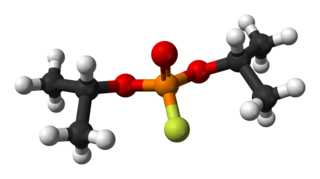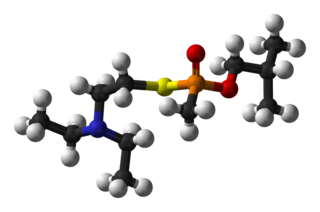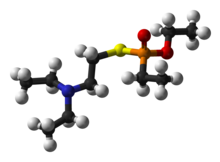Nerve agents, sometimes also called nerve gases, are a class of organic chemicals that disrupt the mechanisms by which nerves transfer messages to organs. The disruption is caused by the blocking of acetylcholinesterase (AChE), an enzyme that catalyzes the breakdown of acetylcholine, a neurotransmitter. Nerve agents are irreversible acetylcholinesterase inhibitors used as poison.

Tabun is an extremely toxic compound of the organophosphate family. It is not present in nature. At room temperature, the pure compound is a clear and viscous liquid. However, impurities imparted during its manufacture are almost always present, turning it into a yellow or brown liquid. Exposed to environs, it slowly volatizes into the atmosphere, with the vapor having a slight fruity or almond-like odor. As the compound has a much higher molecular mass compared to air, Tabun gas tends to accumulate in low-lying areas.

VX is an extremely toxic synthetic chemical compound in the organophosphorus class, specifically, a thiophosphonate. In the class of nerve agents, it was developed for military use in chemical warfare after translation of earlier discoveries of organophosphate toxicity in pesticide research. In its pure form, VX is an oily, relatively non-volatile liquid that is amber-like in colour. Because of its low volatility, VX persists in environments where it is dispersed.
Binary chemical weapons or munitions are chemical weapons which contain the toxic agent in its active state as chemical precursors that are significantly less toxic than the agent. This improves the safety of storing, transporting, and disposing of the weapon. Commonly, firing the munition removes a barrier between two precursors. These react to form the intended agent which is then aerosolized and distributed by a bursting charge.

VM (Edemo) is a "V-series" nerve agent closely related to the better-known VX nerve agent.

VG is a "V-series" nerve agent chemically similar to the better-known VX nerve agent. Tetram is the common Russian name for the substance. Amiton was the trade name for the substance when it was marketed as an insecticide by ICI in the mid-1950s.
The Newport Chemical Depot, previously known as the Wabash River Ordnance Works and the Newport Army Ammunition Plant, was a 6,990-acre (28.3 km2) bulk chemical storage and destruction facility that was operated by the United States Army. It is located near Newport, in west central Indiana, thirty-two miles north of Terre Haute. The site was used as a production site for the solid explosives trinitrotoluene and RDX, as well as for heavy water. It also served as the production site for all of the U.S. military's nerve agent VX, when it was in use. All VX nerve agent at the site was neutralized by August 8, 2008. It was the third of the Army's nine chemical depots to completely destroy its stockpile.
Novichok is a family of nerve agents, some of which are binary chemical weapons. The agents were developed at the GosNIIOKhT state chemical research institute by the Soviet Union and Russia between 1971 and 1993. Some Novichok agents are solids at standard temperature and pressure, while others are liquids. Dispersal of solid form agents is thought possible if in ultrafine powder state.
Chemical, biological (CB) — and sometimes radiological — warfare agents were assigned what is termed a military symbol by the U.S. military until the American chemical and biological weapons programs were terminated. Military symbols applied to the CB agent fill, and not to the entire weapon. A chemical or biological weapon designation would be, for example, "Aero-14/B", which could be filled with GB, VX, TGB, or with a biological modification kit – OU, NU, UL, etc. A CB weapon is an integrated device of (1) agent, (2) dissemination means, and (3) delivery system.

Diisopropyl fluorophosphate (DFP) or Isoflurophate is an oily, colorless liquid with the chemical formula C6H14FO3P. It is used in medicine and as an organophosphorus insecticide. It is stable, but undergoes hydrolysis when subjected to moisture.

VR is a "V-series" unitary nerve agent closely related to the better-known VX nerve agent. It became a prototype for the series of Novichok agents. According to chemical weapons expert Jonathan Tucker, the first binary formulation developed under the Soviet Foliant program was used to make Substance 33, differing from VX only in the alkyl substituents on its nitrogen and oxygen atoms. "This weapon was given the code name Novichok."

Isopropyl aminoethylmethyl phosphonite, also known as O-(2-diisopropylaminoethyl) O′-ethyl methylphosphonite, is a precursor chemical to the nerve agent VX and VR-56. It is a colorless liquid with a strong fishy odor, and is slightly soluble in water.

A-234 is an organophosphate nerve agent. It was developed in the Soviet Union under the FOLIANT program and is one of the group of compounds referred to as Novichok agents that were revealed by Vil Mirzayanov. In March 2018, the Russian ambassador to the UK, Alexander Yakovenko, claimed to have been informed by British authorities that A-234 had been identified as the agent used in the poisoning of Sergei and Yulia Skripal. Vladimir Uglev, one of the inventors of the Novichok series of compounds, said he was "99 percent sure that it was A-234" in relation to the 2018 Amesbury poisonings, noting its unusually high persistence in the environment.

EA-3990 is a deadly carbamate nerve agent. It is lethal because it inhibits acetylcholinesterase. Inhibition causes an overly high accumulation of acetylcholine between the nerve and muscle cells. This paralyzes the muscles by preventing their relaxation. The paralyzed muscles include the muscles used for breathing.

EA-4056 is a deadly carbamate nerve agent. It is lethal because it inhibits acetylcholinesterase. Inhibition causes an overly high accumulation of acetylcholine between the nerve and muscle cells. This paralyzes the muscles by preventing their relaxation. The paralyzed muscles includes the muscles used for breathing.

VS is a nerve agent of the V-series. Its chemical structure is very similar to the VX nerve agent, but the methyl group on the phosphorus atom is replaced by an ethyl group.
Chinese VX (CVX), also known as EA-6043, is an organophosphate nerve agent of the V-series. It is a structural isomer of both VX and Russian VX.

EA-1763, O-PPVX, V1 or propyl S-2-diisopropylaminoethylmethylphosphonothiolate is a military-grade neurotoxic organophosphonate nerve agent related to VX as it is the propyl analogue of VX. It is part of the V-series.

QL sulfide is an isomer of the nerve agent VX. It is a sulfide of the chemical QL, or isopropyl aminoethylmethyl phosphonite.














